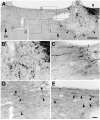Growth factors and combinatorial therapies for CNS regeneration
- PMID: 17927983
- PMCID: PMC2408882
- DOI: 10.1016/j.expneurol.2007.08.004
Growth factors and combinatorial therapies for CNS regeneration
Abstract
There has been remarkable progress in the last 20 years in understanding mechanisms that underlie the success of axonal regeneration in the peripheral nervous system, and the failure of axonal regeneration in the central nervous system. Following the identification of these underlying mechanisms, several distinct therapeutic approaches have been tested in in vivo models of spinal cord injury (SCI) to enhance central axonal structural plasticity, including the therapeutic administration of neurotrophic factors. While several tested mechanisms apparently enhance axonal growth, more recent, properly controlled studies indicate that experimental approaches to combine therapies that target distinct neural mechanisms achieve greater axonal growth than therapies applied in isolation. The search for combination therapies that optimize axonal growth after SCI continues.
Figures


References
-
- Bhatheja K, Field J. Schwann cells: origins and role in axonal maintenance and regeneration. Int J Biochem Cell Biol. 2006;38:1995–1999. - PubMed
-
- Blits B, Oudega M, Boer GJ, Bunge M, Verhaagen J. Adeno-associated viral vector-mediated neurotrophin gene transfer in the injured adult rat spinal cord improves hindlimb function. Neuroscience. 118:271–281. - PubMed
-
- Boyd JG, Gordon T. Neurotrophic factors and their receptors in axonal regeneration and functional recovery after peripheral nerve injury. Mol Neurobiol. 2003;27:277–324. - PubMed
-
- Bradbury EJ, Khemani S, Von R, King, Priestley JV, McMahon SB. NT-3 promotes growth of lesioned adult rat sensory axons ascending in the dorsal columns of the spinal cord. Eur J Neurosci. 1999;11:3873–3883. - PubMed
Publication types
MeSH terms
Substances
Grants and funding
LinkOut - more resources
Full Text Sources
Other Literature Sources

